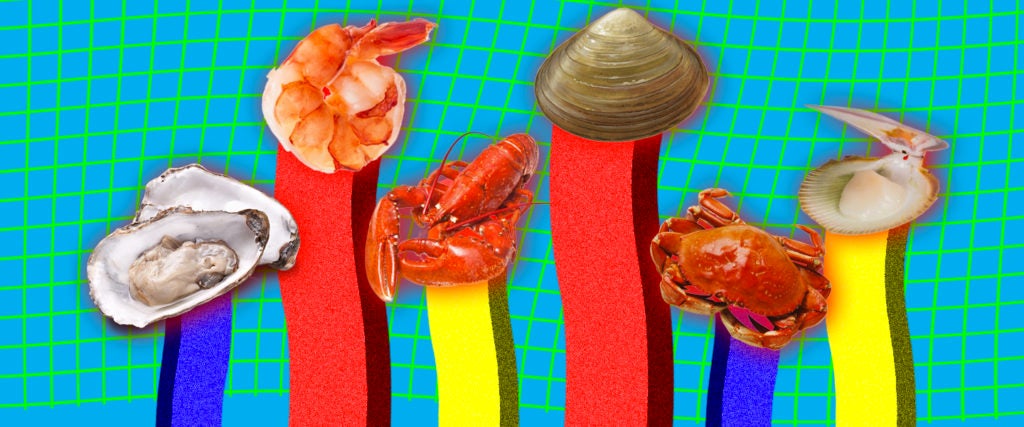If anything could prompt a seafood lover to squirt from their blowhole, surely it would be a mountainous platter of crabs, oysters and scallops. But there are a few key things to consider in regards to how shellfish impact our overall health. For advice, I asked Dana Hunnes, senior dietitian at the Ronald Reagan UCLA Medical Center, if she could help me rank an assortment of shellfish by how healthy they are — instead, she taught me an important (and very depressing) lesson about our oceans.
First, Hunnes shares a paragraph from her upcoming book on sea creatures and plastics in the ocean to emphasize just how polluted our seafood — and especially our shellfish, most of which are bottom feeders or filter feeders — has become: “Plastic — an ever-more pervasive threat — is harmful to marine-animals’ health; and our own. Nearly 8 million metric tons of plastic debris enter the oceans every year. When they ingest it, fish and other marine animals store plastic — and other — chemical byproducts in their fats, where they bio-accumulate up the food chain to larger animals, and finally to humans. In Indonesia, anthropogenic debris (primarily plastic) was found in 28 percent of individual fish’s digestive tracts and in 55 percent of all species. In the U.S., anthropogenic debris (primarily plastic-based fibers) was found in 25 percent of individual fish’s digestive tracts and in 67 percent of all species. Anthropogenic debris was found in 33 percent of individual shellfish’s digestive tracts sampled. By 2050, there may be more plastic (by weight) in the oceans than fish! There will be increased exposure to toxic chemicals, carcinogens and other endocrine-disrupting compounds, with the potential for public-health consequences.”
In simpler terms, humans dumped a bunch of crap in the ocean, shellfish are eating that crap, humans are eating those shellfish and therefore creating a grand cycle of crap consumption. One 2017 study found that Europeans consume up to 11,000 particles of microplastics a year due to their consumption of seafood, and that number is estimated to reach 780,000 by 2100, as we continue destroying the ocean. Knowing all of that, Hunnes says, “I don’t really feel comfortable ranking them, because I feel quite strongly that people shouldn’t be eating them.”
Unfortunately, plastics are only the beginning of our shellfish problem. A 2009 study found that shellfish in some areas contain twice the recommended daily intake for cadmium, a heavy metal that can cause organ damage and other health problems. Similarly, shellfish are one of the leading causes of foodborne illness, because they absorb bacteria, viruses and parasites from their environment — and as I already explained, their environment freaking sucks. One review found that mollusks — clams, scallops, oysters, mussels — accounted for more than 45 percent of the seafood-related cases of foodborne illness in the U.S. from 1973 to 2006.
To top off the long list of dangers associated with eating shellfish, more than seven million Americans are thought to be affected by shellfish allergies. So, it would be fair to say that eating shellfish truly is a YOLO-esque activity.
All of that said, there are scientists who claim that the levels of toxins and plastics in shellfish remain low enough, for the time being, to eat them on an occasional basis, like once or twice a week. This is in part because eating plastic has become an inevitability for humans, but hey, life is short and sometimes you have to eat some shellfish. Plus, sourcing good shellfish — which, here, have this handy guide — can help keep the toxins to a minimum.
So, with all the bad news out of the way, we can at least celebrate the fact that shellfish have the potential to be healthy — before we went and dumped all that crap in the ocean. In their freshest forms, they consist of lean protein, healthy omega-3 fatty acids, which bolster brain and heart health, and all sorts of important micronutrients. And if you really want a ranking, you could rank shellfish by how much protein they have per 3-ounce serving. Thus, I present to you…
Healthiest Shellfish, Ranked
- Shrimp: 17 grams
- Crab: 15 grams
- Crayfish and Lobster: 14 grams
- Clams: 12 grams
- Scallops and Mussels: 10 grams
- Oysters: 8 grams
You should also keep in mind that shellfish are healthiest when steamed or baked, not breaded or fried.
Enjoy your plastic with a side of shellfish!

